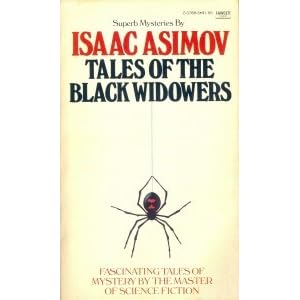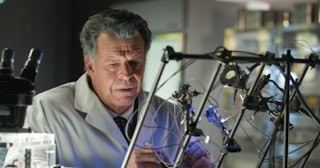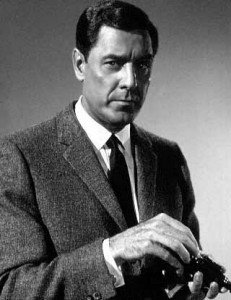mooning about in a daze of love such as I had not known for any character in
literature since I encountered Sir Launcelot at the age of nine. (Launcelot and
Spade - they're pretty far apart, yet I played Elaine to both of them, and in that
lies a life-story.)" Dorothy Parker, The New Yorker, April 25, 1931, p. 92
Me and Dorothy have a lot in common. I, too have mooned after Sam Spade, Simon Templar, Nick Charles, James Bond (I'm a Sean Connery gal), Lord Peter Wimsey, Sir Gawain, Prince Valiant, Rhett Butler, and Thomas Hewlitt Edward Cat. See Robert Loggia below - I loved that show. I watched every episode for its two year run. Besides the fact that I thought Mr. Loggia was pretty darned hot, it was set mostly at night, with lots of cool jazz music - he owned his own jazz bar - and references to gypsies and jewel thieves, and I thought that was pretty much the kind of life I wanted to lead. Note to Netflix: get this show on DVD!
But none of these were role models. For that I needed women, and strong, interesting women were hard to find back in the 1960's, when Donna Reed et al were still vacuuming wearing high heels and pearls. Here are some of the women whom I admired and modeled myself after when I was a child:
 Elizabeth I. The original great leader, sharp and witty, supremely well educated, steely, manipulative, able to get and keep her throne in an age of beheadings, able to keep her country out of almost all wars, dignified, bawdy, athletic, musical, and poetic. Do not even get me started on her antithesis, Mary, Queen of Scots. Anyone stupid enough to marry the chief suspect in her husband's murder deserves whatever she gets. Elizabeth had the good sense to stay single, both because it was to her taste and because she knew that no husband would ever please her countrymen. "I would rather be a beggar woman and single than
to be a Queen and married."
(But I personally don't believe she was a virgin...)
Elizabeth I. The original great leader, sharp and witty, supremely well educated, steely, manipulative, able to get and keep her throne in an age of beheadings, able to keep her country out of almost all wars, dignified, bawdy, athletic, musical, and poetic. Do not even get me started on her antithesis, Mary, Queen of Scots. Anyone stupid enough to marry the chief suspect in her husband's murder deserves whatever she gets. Elizabeth had the good sense to stay single, both because it was to her taste and because she knew that no husband would ever please her countrymen. "I would rather be a beggar woman and single than
to be a Queen and married."
(But I personally don't believe she was a virgin...)Anyway, she managed to keep her country free, her ministers subordinate, and live pretty much as she wanted to live for almost 50 years. On top of that, she was one of the first to realize that religion was a lousy excuse for burning a man, and pursued the first "don't ask, don't tell" policy (re religion) in history. "I have no desire to make windows into men's souls." (Eventually she did have to send some people to the fire, but they did keep trying to kill her.) Yes, she was overdressed. Yes, she was vain. Yes, she was an autocrat. But she also said, and I believe she meant it, "There will never Queen sit in my seat with more zeal to my country, care to my subjects and that will sooner with willingness venture her life for your good and safety than myself. For it is my desire to live nor reign no longer than my life and reign shall be for your good. And though you have had, and may have, many princes more mighty and wise sitting in this seat, yet you never had nor shall have, any that will be more careful and loving." She made GREAT speeches.
Okay, on to pop culture.
Emma Peel. In an age when most women were running screaming from villains and tripping at the first available opportunity, or huddling in fear, waiting to be rescued, Mrs. Peel was the first woman I ever saw who rescued the guy. She was beautiful, well-educated, athletic, musical, stylish, witty, and could kick some serious butt. And she had class. Whatever happened between her and Steed or her and anyone else was private. The double-entendres were subtle (and oh, how I miss those days!). I admit that the plots of "The Avengers" ranged from clever to just plain stupid, but I never missed an episode.
Harriet Vane. I hear that some people feel about her the way I feel about Susan Silverman although I don't understand why. To me, Harriet was an intelligent, well-educated, witty, musical, athletic woman who could solve a murder just as well as her would-be lover and future husband, Lord Peter Wimsey. I also liked that she wasn't physically beautiful - not all of us are - and it didn't matter, to Peter or to herself. She had a wonderful voice, could look striking, was passionate and intellectual and liked a good wine. And she had a successful writing career, supporting herself so that she was dependent on no one but herself. I liked all of it.
Nora Charles. (Note to Dorothy, I changed my mind: I'll take Nick over Sam any day.) Fun. Smart. Witty. Great marriage. Good times. Can't ask for much more than that...

NOTE: During the next 3-4 weeks, my husband and I will be moving to the bottom floor of an old school in Madison - lots of room, so we're not downsizing too much. Anyway, this means chaos, heartburn, aching backs, and not too much writing. I've logged ahead my blog posts for the month, but I may not be checking in as much as usual. Forgive me, and I will say hi when I can!





















 by Janice Law
by Janice Law
 The answer to this is kept in suspense and many of the episodes are constructed as investigations, as Carrie Mathison attempts to prove her suspicion that Brodie has been 'turned' during captivity. Even when it is clear that Brodie is not what he seems, his complex character and his mix of restraint and violence prevent any easy answers.
The answer to this is kept in suspense and many of the episodes are constructed as investigations, as Carrie Mathison attempts to prove her suspicion that Brodie has been 'turned' during captivity. Even when it is clear that Brodie is not what he seems, his complex character and his mix of restraint and violence prevent any easy answers.



